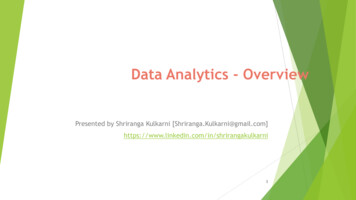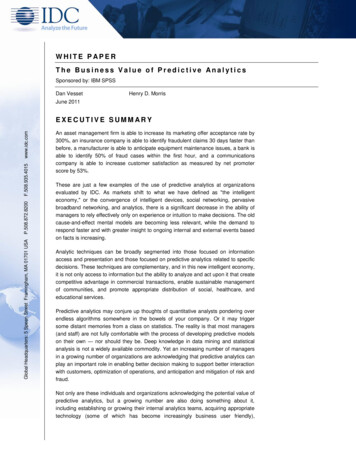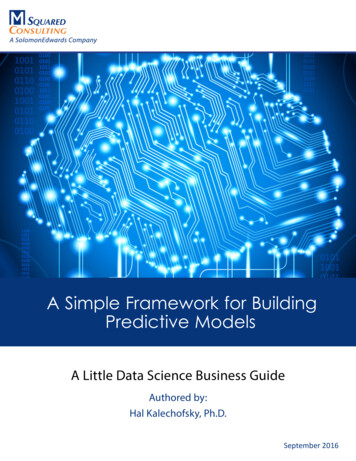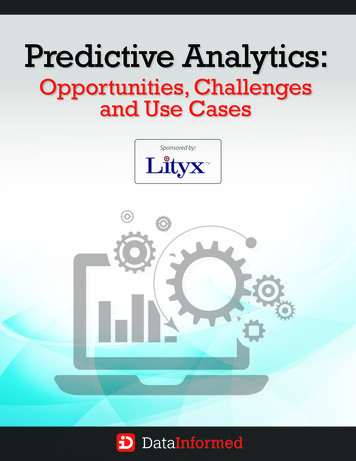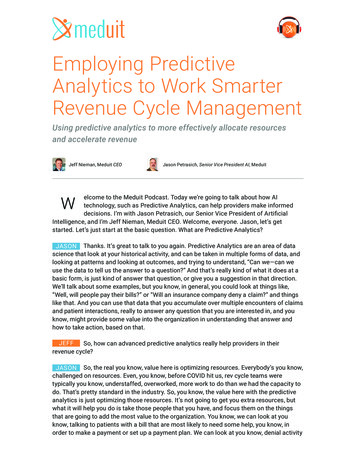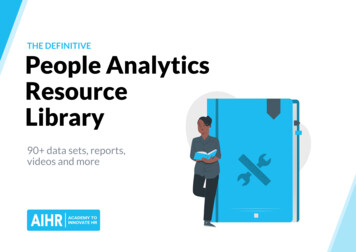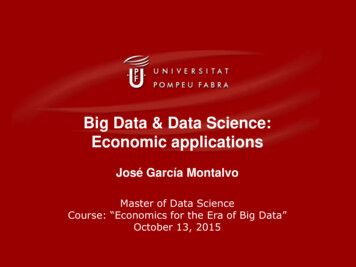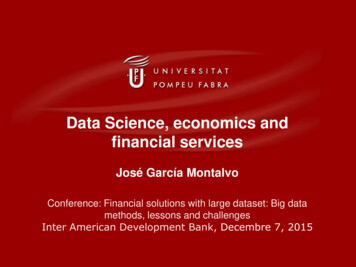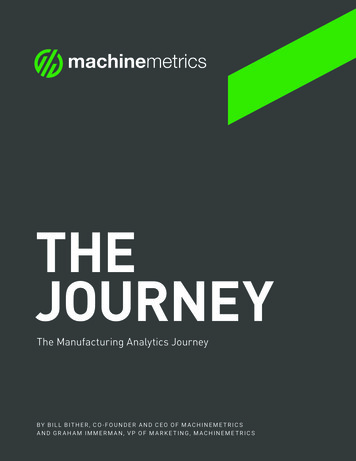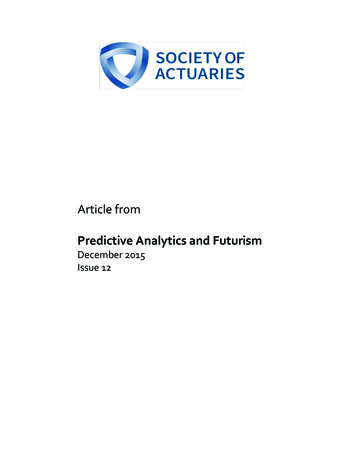
Transcription
Article fromPredictive Analytics and FuturismDecember 2015Issue 12
Getting Started inPredictive Analytics:Books and CoursesBy Mary Pat CampbellBack in September 2009, this section sported a brand newname: the Forecasting & Futurism Section (before it hadbeen the Futurism Section). In the inaugural newsletterthat month, introducing the new name, there was also an articleintroducing Forecasting concepts: “Introduction to ForecastingMethods for Actuaries” by Alan Mills. Alan put together a handytable listing common forecasting approaches in actuarial work, aswell as references for those methods.At the time, “Predictive modeling” was relatively new, and he notedit was gaining in popularity.Here is how Alan described the method:“An area of statistical analysis and data mining, that dealswith extracting information from data and using it to predict future behavior patterns or other results. A predictivemodel is made up of a number of predictors, variables thatare likely to influence future behavior.”1Since that overview article from six years ago, predictive modelingand analytics have taken off—so much so, it’s now part of the namefor the section!“Predictive analytics” and “Predictive modeling,” have caught onbroadly, and in insurance, first being particularly used in property& casualty pricing applications. “Big data” has really risen in popularity as a search term since 2012 perhaps partly due to theprominence of people like Nate Silver of 538 fame.“Data Source: Google Trends (www.google.com/trends).” See l en.Actuaries have the ability to pick up predictive analytics concepts—some of which are not very complicated at all, just being linear regression models from large data sets. But predictive analytics goesbeyond Generalized Linear Models, and even with GLMs thereare niceties that actuaries should know about.BUT WHERE TO BEGIN?Below are some resources for the beginner in predictive analytics and sometimes a nice way for those already well-versedin many of the techniques to expand to a few more they had notconsidered.There are two main threads involved in getting started with predictiveanalytics:1. S tatistical theory and modeling—understanding the approaches,what each does, and what the strengths and weaknesses are forthese; and2. Computing—specialized software and languages intendedfor crunching Big Data and performing analytics.I am going to try to pick resources that combine the two, butsometimes that is not possible. For the most part, I will be highlighting free or inexpensive resources.BOOKSSTATISTICS (THE EASIER WAY) WITH R BY NICOLE RADZIWILLWeblinksFree preview: 015/04/radziwill statisticseasierwithr preview.pdfAmazon link for book: http://amzn.to/1URjyQDLanguages/TopicsR and Introductory statistics—confidence intervals, regression,and statistical inferenceLevelAbsolute beginnerI partly picked this book because the author is a long-time friend,but also because this is a very easy entry into using R as well asthinking about statistical models. The statistics material in the text“Data Source: Google Trends (www.google.com/trends).” See l en.14 DECEMBER 2015PREDICTIVE ANALYTICS AND FUTURISM
is similar to the syllabus of the Statistics VEE, so the topics shouldbe familiar to actuaries.R is a free statistical software package, and thus is used in many ofthe predictive modeling texts one finds. However, most statisticstexts using R have a large gap in explaining how one uses R and most R texts have a large gap in explaining the statistics whilewalking you through how to use R.This text just gets you started in these techniques in some cases,just enough to make you dangerous. While Joel does sometimescover the pitfalls of certain techniques, his focus is primarily onhow one executes certain types of analyses and not how they maygo extremely wrong.AN INTRODUCTION TO STATISTICAL LEARNING WITH APPLICATIONS IN R, BY GARETHJAMES, DANIELA WITTEN, TREVOR HASTIE, AND ROBERT TIBSHIRANIWeblinksNicole developed this text through her own classes at James MadisonUniversity in Virginia (Dr. Radziwill is an assistant professor in Integrated Science and Technology at JMU) geared at undergraduatescience majors. As Nicole writes, one of her target audiences was:“Smart, business-savvy people who want to do more dataanalysis and business analytics, but don’t know where to startand don’t want to invest hundreds or thousands of dollars onstatistical software!”I have gone back to Nicole’s text as a reference for doing certainthings in R, because she walks through every step. This book islong as a result of the step-by-step R code, but I have found thismore helpful than trying to Google “how to do X in R.”DATA SCIENCE FROM SCRATCH: FIRST PRINCIPLES WITH PYTHON BY JOEL GRUSWeblinksJoel’s site: http://joelgrus.com/Amazon link for book: http://amzn.to/1URkqoALanguages/TopicsOverview of multiple data analysis techniques, Python, SQLLevelBeginnerPython is another widely-used language in data analytics. While Rwas developed originally for statisticians, Python is a more general use programming language. That has led to differing groups ofpeople developing already-created/written code for Python and R.Python is an extremely popular language due to its relative ease inuse compared with other languages, and there have been several numerical computing packages developed for Python, such as numpy.2Another disclosure: I am also friends with Joel Grus and previewedthis text I have a lot of friends. Joel is currently a software engineer at Google.In this text, there is a quick introduction to Python—enough torun and adjust the code in the text. In addition to the linear regression and inference concepts that are also in the Statistics withR text previously, this text covers: clustering algorithms, Bayesian approaches, logistic regression, neural networks, and networkanalysis. He also covers SQL, because much of the data being usedin the data-crunching first originated from SQL databases.Book’s website: http://www-bcf.usc.edu/ gareth/ISL/book.htmlAmazon link: http://amzn.to/1URmvALOnline videos (free!): e-learning-videos/Languages/TopicsMore rigorous approach to statistical inference/modelingtechniques, RLevelIntermediateFor my last book recommendation, here is a more formal text(though “squishier” than the more advanced The Elements of Statistical Learning by a non-empty intersecting set of authors). Itis more expensive than the two prior books, as this is a regularcollege text, and has the accompanying pricing.That said: there is a complete set of online videos from a classbased on this text. This will provide a link to the online courses Ipromote below.I have been very slowly going through this text the slowness dueto me jumping back to other resources on R, so I make sure I understand what I’m doing. That’s the weakness with this text—the Ris not well-explained for the newbie. I would not start with this textfor learning R, but once you’ve got a founding in R, the exercisesin R are not so bad.What’s really nice is that you don’t actually have to do any of thesections with R—if all you want are the concepts, you can skip theparts in R and pay attention to their worked-out examples.Still, I think that doing the hands-on applied exercises in R is important in putting the pieces together.As this is a “real” college textbook, it has end-of-chapter exercises, divided into “Concept exercises” and “Applied exercises.” I really liked the “concept exercises” as they were geared to havingthe student probe that they really understand what is going on,and these exercises are very much geared towards thinking aboutwhich techniques are appropriate for which modeling tasks.DECEMBER 2015 PREDICTIVE ANALYTICS AND FUTURISM 15
Getting Started .As an example, here is the question and my proposed answer forone of the conceptual exercises:“4. You will now think of some real-life applications for statistical learning.(a) Describe three real-life applications in which classification might beuseful. Describe the response, as well as the predictors. Is the goal of eachapplication inference or prediction? Explain your answer.Classification may be useful if you’re putting together policyholder data/response: underwriting in life insurance—have discrete u/w classes as opposed tomore continuous u/w; might want to classify policyholders as being reactive/hot money vs.passive—very important in variable annuities; and might want to flag claims for possible fraud, but don’t want to spend tooMy R code for the book’s applied exercises can be found here:https://github.com/meepbobeep/ISLRmuch resources investigating every claim.(b) Describe three real-life applications in which regression might be useful.Describe the response, as well as the predictors. Is the goal of each application inference or prediction? Explain your answer.Regression useful in insurance: more continuous u/w as seen in auto coverages; if want to consider more continuous life u/w as with John Hancock’s Disclosure: I am not friends with any of the authors of the following texts. Yet.ONLINE COURSESFitbit program; andDATACAMP used in putting together projections of exposure in various p/c picsR and data science in generalLevelAbsolute beginner to intermediateTimingOn-demand, very short lessonsPaid featuresAccess to all courses, statement of completionCredentialsStatement of completionages. Can’t observe everything while u/w, but may be able to find keyvariables.(c) Describe three real-life applications in which cluster analysis might beuseful. Topics covered in this text: linear regression, classification, resampling/bootstrapping, model selection, dimension reduction inmodels, nonlinear models, tree-based methods (such as decisiontrees), support vector machines, unsupervised learning. might be wanting to see if one can come up with new u/w buckets—clus-there are clear outliers in exam performance” (COUGH COUGH CAS).Datacamp has online lessons in R, which I originally found outabout via a class on edX. Like many of the online courses below,they keep trying to upsell you. The pricing is by time period—either by month or by year (cancel any time!) I have tried only theirfree content, which tends to be the introductory classes. I supposethey figure if you get a taste, you’ll want more.As I said, I’ve been working through this text, and my notes can befound at my dropbox: Learning.docx?dl 0 I have been trying to put in insurance/pension-related applications in answers to conceptual questions, butfor some of the topics, it gets to be a bit challenging to think ofactuarial applications but give me time.I thought these lessons were very well-done, taking you stepby-step through R and some of the major tasks one wouldwant to do in R when doing predicative analytics. However,the material I see on the site, even the paid courses, don’t getto a very advanced level. However, it does touch on using Rin ways the prior texts don’t: for prettier graphs and dynamicreporting.ter analysis may help; I used cluster analysis to see if there’s common asset allocation strategies among life insurers—help tease apart influences; and could be used by exam committees to compare current exams againsthistorical, check out various metrics (other than Euclidean) to see if16 DECEMBER 2015PREDICTIVE ANALYTICS AND FUTURISM
I found these lessons were very rapid to go through, and I’m thinking of paying for the one month of access . should be no problemto go through 18 available courses over the Christmas break, right?One of the nice features of the introductory courses is that you donot need to install R yourself—you will be able to run R code inthe browser ages/TopicsData analysis, R, Python, SQL, Hadoop, (and much, much more)LevelBeginner to advancedTimingOn-demand, usually takes a few months for a full course (somemini-classes are shorter). Nanodegree and regular degreeprograms are on a schedulePaid featuresMonthly charge for access to coaches, projects with ongoingfeedback, verified certificates and degrees (normal and nano-)CredentialsVerified certificates, Georgia Tech MS in Computer Science,coming soon: nanodegreesUdacity has a coding focus, along with applications such as withFront-end development and Data Analysis. For this review, I’monly looking at the courses in the Data Analysis nanodegree.The classes on Udacity are more like regular classes, with quizzesand assignments. Udacity also has video lectures. Classes are ratedfor level, the advanced classes tend to have programming experience prerequisites. They have classes with serious Computer Science content, not only about how to program. They have classesbuilt by various well-known tech companies, such as Facebook,Google, Amazon Web Services, Salesforce, and Twitter.In addition to verified certificates for specific classes, and their partnership with Georgia Tech to provide an online-only M.S. in Computer Science, Udacity has recently created “nanodegrees” in specific areas, one of which is for data analysis. These nanodegrees areintended to be completed in less than a year. It looks like there wasgreat demand, because they increased the fee for the nanodegreesfrom 150/month to 200/month in the past year, and have restricted enrollment in the nanodegrees to certain times of the year.To access the classes for free, just click on “Start free course” onthe specific class page. You can get to all the material: videos, textfiles, and even assignments. Within the videos themselves, theyoften stop for quizzes for immediate checking of understanding.Obviously, there are features you can’t access if you aren’t paying.The courses that are free are generally available on-demand.The main place to start for their data analysis courses is Introto Computer Science, which is mainly about learning to codeDECEMBER 2015 PREDICTIVE ANALYTICS AND FUTURISM 17
Getting Started .in Python. It seems most of their data analysis classes dependon guages/TopicsSo very much!LevelBeginner to advancedTimingMost on specific schedules, 4-week to semester-long courses; avery few are on-demandPaid featuresCertifications (see below)CredentialsSignature Track credential, Specialization certificates fromsponsoring universitiesLots of courses to choose from at Coursera, and my main warning is to check prerequisites. Some of the numerical computingcourses assume you know specific languages at particular levels.Some are truly introductory, and will walk you through how to getstarted in various languages, but many are at intermediate levelsor higher for the coding, especially in the data analysis courses, soyou want to be careful.Got any favorite resources for the beginner in predictive modelingand data analytics? Let me know about them—marypat.campbell@gmail.com.ENDNOTESI find Coursera the most dangerous of all the websites to go to because there’s so much there, and not all of it is programming.Looking at the list of stuff I’ve signed up for on this site: The DataScientist’s Toolbox, R Programming, Exploratory Data Analysis,Fundamentals of Music Theory, A Beginner’s Guide to IrrationalBehavior, Machine Learning, Introduction to Mathematical Thinking, Data Analysis, Comic Books and Graphic Novels, Computingfor Data Analysis, An Introduction to Financial Accounting, Exploring Beethoven’s Piano Sonatas, The Science of Gastronomy, Coding the Matrix: Linear Algebra through Computer Science Applications, Introduction to Data Science, and Gamification.That’s not necessarily exhaustive.I obviously don’t have enough time to seriously pursue all thesecourses, especially since, unlike the other sites listed above, most ofthese classes are built to specific time schedules, with classes starting and ending on particular dates. Usually, I’m only seriously following one class at any given time and downloading all the PDFs,videos, and other supporting documents completely free. I haveused some of the items I’ve come across to teach my own courseson other topics.All of the courses on Coursera are backed by accredited institutions, and thus Coursera has a more academic feel than Udacity.Some of the classes come with paid certifications, and some courses have no free version at all. Many of the business-related dataanalytics courses are like that, I find.Like Udacity, Coursera has developed something akin to “nanodegrees” called Specializations, which are short tracks of verifiedcourses that take about a year to complete. A few of the Specialization tracks available as I write this article are Machine Learning(University of Washington, six courses), Big Data (UC-San Diego,six courses), Business Analytics (University of Pennsylvania, fivecourses).18 DECEMBER 2015PREDICTIVE ANALYTICS AND FUTURISM1Alan Mills, “Introduction to Forecasting Methods for Actuaries.” Forecasting & Futurism Newsletter, September 2009. pp 6-9. w.numpy.org/Mary Pat Campbell, FSA, MAAA, PRM, is VP, insuranceresearch at Conning in Hartford, Conn. She can bereached at marypat.campbell@gmail.com.
Predictive Analytics: Books and Courses By Mary Pat Campbell Actuaries have the ability to pick up predictive analytics concepts— some of which are not very complicated at all, just being linear re-gression models from large data sets. But predictive analytics goes b

